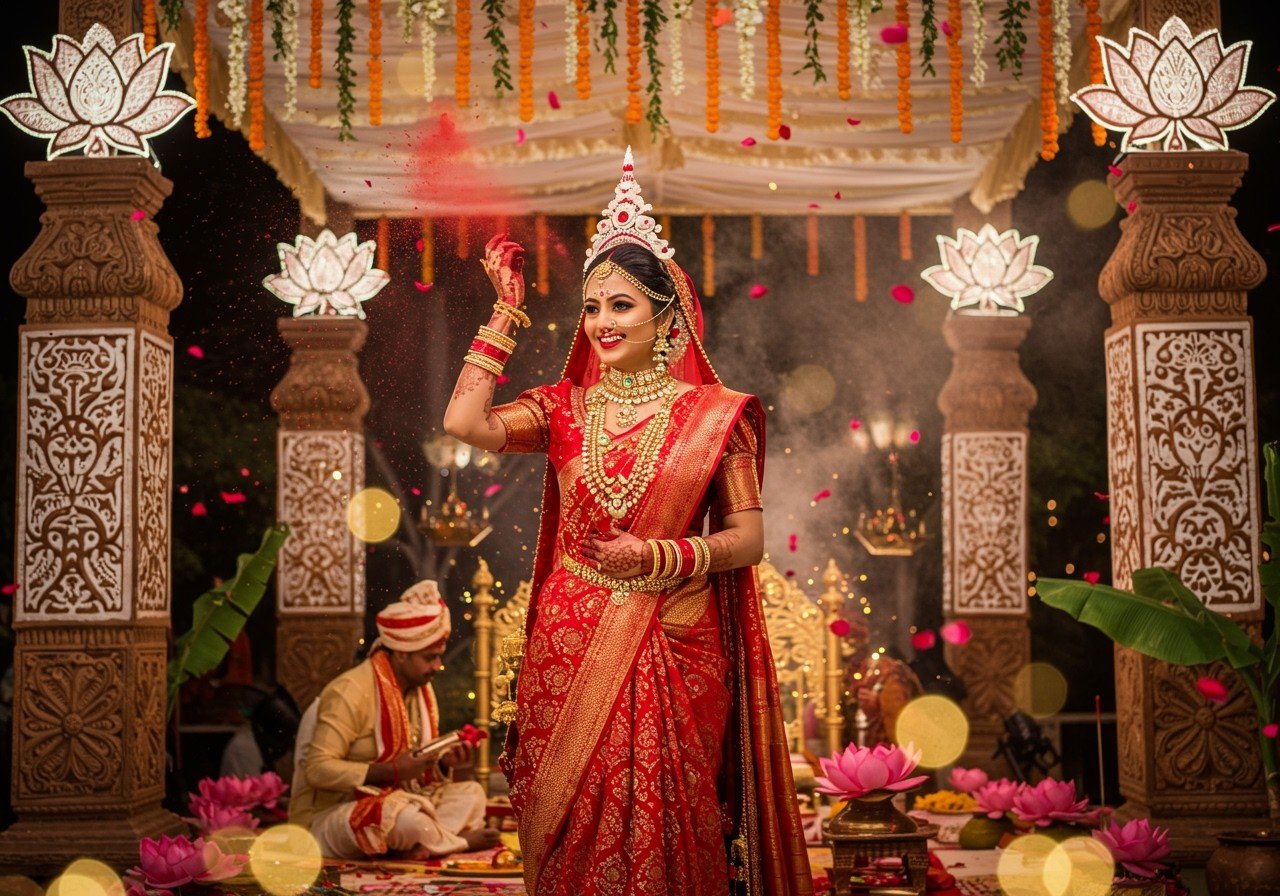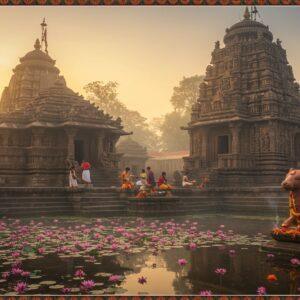
Bengali Hindu weddings are a vibrant tapestry woven with threads of ancient customs, joyous celebrations, and profound spiritual significance. They mark not merely the union of two souls, but the intertwining of two families, creating a bond that stretches across generations. This guide is designed to illuminate these beautiful ceremonies, offering insights into their rich symbolism and practical guidance for those seeking to incorporate authentic elements into their own celebrations.
Pre-Wedding Rituals: Setting the Stage for a Lifetime of Togetherness
The journey towards marital bliss begins with a series of pre-wedding rituals, each carrying its own unique significance. These customs prepare the couple and their families for the sacred bond they are about to forge.
- Adan Pradan: This initial meeting between families sets the tone for the wedding, finalizing the date and laying the groundwork for a harmonious union. It’s a time for families to connect, share expectations, and begin building a relationship that will last a lifetime.
- Aashirbaad: More than just an engagement, the Aashirbaad is a shower of blessings and well wishes. Families bestow gifts of gold, clothing, sweets, and symbolic items like fish, betel leaves, and curd upon the couple. This symbolizes their acceptance and heartfelt approval of the union, setting a positive and supportive atmosphere for the upcoming wedding.
- Aiburobhaat: This poignant feast is the bride and groom’s last meal as unmarried individuals. It’s a celebration of their singlehood, a chance to savor favorite dishes with loved ones, and a time to reflect on the journey that lies ahead. This tradition acknowledges the transition they’re about to make.
- Ganga Nimantran: A symbolic invitation to the holy River Ganga, this ritual involves a procession to the riverbank to collect water. This sacred water is then used in wedding ceremonies, invoking blessings and purity for the couple’s new life together. It’s a powerful connection to nature and spirituality.
- Dodhi Mangal: On the morning of the wedding, a simple yet significant meal of soaked flattened rice with yogurt is offered to the couple. This marks the beginning of their wedding day fast, a practice that symbolizes purification and devotion. It’s a quiet moment of reflection amidst the excitement.
- Gaye Holud: The vibrant turmeric ceremony fills the air with laughter and blessings. Turmeric paste is applied to the groom, then sent to the bride’s home along with gifts, symbolizing good health and prosperity. The bride, dressed in a yellow saree, is then also adorned with turmeric paste, signifying her readiness for married life. It is a ceremony full of joy and anticipation.
- Sankha Pola: Adorning the bride’s wrists with white and red conch shell bangles marks a significant step. These bangles, known as Sankha and Pola, are traditional symbols of Bengali marriage, representing her new status and the promise of a prosperous future. These beautiful adornments are a tangible representation of her commitment.
Find Authentic Topor Mukut Sets Here
Main Wedding Rituals: A Sacred Union of Two Souls
The heart of the Bengali wedding lies in its main rituals, each steeped in tradition and symbolism, weaving together the couple’s destinies under the watchful eyes of family and friends.
- Bor Boron: The groom’s arrival is met with a warm welcome from the bride’s mother, setting a tone of hospitality and respect. This signifies the acceptance of the groom into the bride’s family, marking the start of a new kinship.
- Potto Bostro: The gifting of new clothes to the groom symbolizes the bride’s family’s acceptance and care. This gesture further strengthens the bond between the two families, demonstrating mutual respect and warmth.
- Saat Paak: A truly unique tradition, Saat Paak sees the bride, seated on a pidi (low wooden stool), carried by her brothers around the groom seven times. This ritual signifies the strengthening of their bond with each circle, representing the seven vows of marriage and their commitment to a shared future.
- Subho Drishti: The first glance, a moment of profound significance, is shared between the bride and groom. After the Saat Paak, the bride lowers the betel leaves shielding her face, meeting the groom’s gaze for the first time. It’s a moment charged with emotion, marking the beginning of their journey as a couple.
- Mala Badal: The exchange of floral garlands is a beautiful expression of mutual acceptance and love. As they exchange garlands three times, they publicly declare their choice to embark on this journey together, surrounded by the joyous blessings of their loved ones. This is a visual representation of their commitment.
- Sampradan: In this deeply emotional ritual, akin to Kanyadaan, the bride’s father (or a senior male relative) formally gives her hand to the groom, entrusting her to his care. This act symbolizes the transfer of responsibility and marks a significant transition in the bride’s life.
- Yagna: The sacred fire, Agni, becomes the witness to the couple’s union during this ritual. As the priest chants mantras, the couple offers prayers, seeking blessings for a prosperous and harmonious future. This is a spiritual cornerstone of the ceremony.
- Saptapadi: With each step around the holy fire, the couple takes seven sacred vows. These vows are not just words, but promises etched in their hearts, guiding them towards a life filled with love, respect, and mutual understanding. This ritual solidifies their commitment in a spiritual and emotional sense.
- Anjali/Onjoli: Offering puffed rice into the sacred fire, the couple seeks prosperity and happiness in their married life. This symbolic act signifies their shared hopes and dreams for the future, invoking blessings from the divine.
- Sindoor Daan and Lajja Bastra: The groom applies sindoor (vermilion) to the bride’s hair parting, marking her status as a married woman. He then covers her head with a new saree (the Lajja Bastra), symbolizing her transition into this new role. It’s a poignant moment that encapsulates tradition and the promise of a shared life.
Explore Our Collection of Wedding Essentials
Post-Wedding Rituals: Embracing a New Beginning
The celebrations continue with post-wedding rituals, marking the bride’s transition into her new family and the beginning of their shared journey as husband and wife.
- Biday: A bittersweet farewell, the Biday is filled with emotion as the bride leaves her parental home. It’s a time for tears and hugs, for remembering cherished moments and looking forward to the future. This is a poignant transition for both families.
- Bou Boron: The bride’s arrival at her new home is met with a warm welcome. She steps into a tray of alta (lac dye) and milk, leaving auspicious red footprints on a white cloth, symbolizing the arrival of Lakshmi, the goddess of prosperity. This signifies her new role as a bringer of good fortune to her new family.
- Basar Ghar: This lighthearted post-wedding gathering brings together family and friends for games, songs, and playful banter. It’s a time for the newlyweds to bond with their loved ones in a relaxed and joyous atmosphere. It strengthens the connections within the extended family.
- Kaal Ratri: This unique custom separates the couple on their first night, believed to ward off negative energies and ensure a harmonious start to their married life. It’s a time for quiet reflection and anticipation for the days ahead.
- Bashi Biye: For some families, the celebrations extend into the next day with the *Bashi Biye*. This continuation of the festivities strengthens the bond between families and provides another opportunity for shared joy and merriment. It signifies ongoing support and love for the newlyweds.
- Bhat Kapor: A symbolic gesture of care, the groom offers the bride a plate of food and a new saree, promising to provide for her needs. The bride then prepares a meal for the family, marking her role as a nurturer in her new home. This is a beautiful exchange of respect and love.
- Bou Bhat: This reception formally introduces the bride to the groom’s extended family and friends, solidifying her place within their community. It’s a celebration of new beginnings and the expansion of family ties. This is a joyous occasion filled with blessings and warm welcomes.
- Dira Gaman: The newlyweds visit the bride’s family for the first time after the wedding, maintaining ties with her loved ones and reinforcing the bond between both families. This is a happy occasion, marking the start of new relationships and continued support.
- Phool Sajya: The couple’s bed is adorned with flowers, symbolizing love, fertility, and new beginnings. They share puffed rice with yogurt, a simple yet meaningful act that marks the start of their shared journey as husband and wife. It is a sweet and intimate closing to the wedding ceremonies.
Find the Perfect Topor for Your Special Day
Poojn.in: Your Partner in Celebrating Bengali Wedding Traditions
At Poojn.in, we understand the importance of authenticity and convenience in preparing for these sacred ceremonies. That’s why we offer a wide selection of traditional Bengali wedding essentials, from exquisite Topor-Mukut sets to high-quality Pooja Samagri. Let us help you make your wedding a truly memorable and blessed occasion.
Explore our curated collection of Bengali wedding items and experience the convenience of online shopping with the assurance of quality and tradition.
Embracing Tradition in the Modern Age
Bengali Hindu weddings are not mere events; they are living narratives that connect generations through the timeless language of ritual and celebration. As we journey into 2025, the spirit of tradition finds a harmonious balance with modern convenience. Poojn.in helps bridge this gap, offering easy access to authentic ritual items, allowing families to focus on the joy and emotional richness of these sacred ceremonies.
Learn more about Rangoli designs and other Hindu wedding traditions to add a touch of artistry and cultural richness to your special day.
Frequently Asked Questions
What is the significance of the ‘Gaye Holud’? The ‘Gaye Holud’ ceremony, with its vibrant turmeric paste, is a symbol of purification and blessings for the couple, preparing them for their journey into married life. It’s a joyous celebration filled with laughter and well-wishes, signifying the beginning of their new chapter.
What are some essential items for a Bengali Hindu wedding? Essential items include the traditional attire, the Topor and Mukut for the bride and groom, conch shell bangles (Sankha Pola), and the various Pooja Samagri for the religious ceremonies. Poojn.in offers a wide range of these essential items, ensuring you have everything you need for a traditional Bengali wedding.
What makes Bengali Hindu weddings unique? The rich cultural heritage, the vibrant rituals like the Gaye Holud and Saat Paak, and the deep emotional significance of each ceremony contribute to the uniqueness of Bengali Hindu weddings. These weddings are a beautiful blend of tradition, spirituality, and joyous celebration.
How can I learn more about Bengali Hindu wedding customs? You can explore various resources online and offline, including books, blogs, and cultural centers, to delve deeper into the fascinating world of Bengali Hindu wedding traditions. Explore our blog on ancient Hindu practices to deepen your understanding of the cultural context surrounding these rituals.


